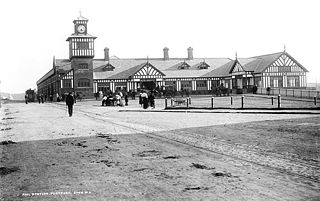
The Nose Electric Railway Co., Ltd., occasionally abbreviated as Nose Railway or Noseden (能勢電), is a Japanese private railway company headquartered in Kawanishi, Hyogo, which links several areas in the mountainous Nose, Osaka, area to Kawanishi-noseguchi Station in Kawanishi, where one can transfer to Hankyu Takarazuka Line to Osaka.
The Lancashire and Yorkshire Railway (LYR) built suburban electric stock for lines in Liverpool and Manchester. The line between Liverpool to Southport began using electric multiple units (EMUs) on 22 March 1904, using a third rail 625 V DC. Additional trains were later built for this route, and in 1913 incompatible stock for the route to Ormskirk. Lightweight units were built to run on the Liverpool Overhead Railway.

The Giant's Causeway Tramway, operated by the Giant's Causeway, Portrush and Bush Valley Railway & Tramway Company Ltd, was a pioneering 3 ft narrow gauge electric railway operating between Portrush and the Giant's Causeway on the coast of County Antrim, Northern Ireland. The line, 9+1⁄4 miles (14.9 km) long, was hailed at its opening as "the first long electric tramway in the world". The Giant's Causeway and Bushmills Railway today operates diesel and steam tourist trains over part of the Tramway's former course.

Baker Motor Vehicle Company was an American manufacturer of Brass Era electric automobiles in Cleveland, Ohio, from 1899 to 1914. It was founded by Walter C. Baker.

In rail transport, head-end power (HEP), also known as electric train supply (ETS), is the electrical power distribution system on a passenger train. The power source, usually a locomotive at the front or 'head' of a train, provides the electricity used for heating, lighting, electrical and other 'hotel' needs. The maritime equivalent is hotel electric power. A successful attempt by the London, Brighton and South Coast Railway in October 1881 to light the passenger cars on the London to Brighton route heralded the beginning of using electricity to light trains in the world.

Doncaster Railway Works is a railway workshop located in Doncaster, England.

The Cadillac Model Thirty is an automobile that was introduced in December 1909 by the Cadillac Division of General Motors, and sold through 1911. It was the company's only model for those years and was based on the 1907 Model G. The 1912 Model 1912, 1913 Model 1913, and 1914 Model 1914 were similar but used larger engines. This platform only used a four-cylinder engine which was permanently cancelled in 1914, as other GM brands would take on the task of offering a less prestigious engine. The 1912 Model 30 was the first production car to have an electric starter rather than a hand crank or spring or other early method.

Columbia was an American brand of automobiles produced by a group of companies in the United States. They included the Pope Manufacturing Company of Hartford, Connecticut, the Electric Vehicle Company, and an entity of brief existence in 1899, the Columbia Automobile Company.

The Butte, Anaconda and Pacific Railway is a short line railroad in the U.S. state of Montana. The BA&P was founded in 1891 and operated as such until sale in 1985, when it was renamed the Rarus Railway. The railway was again sold in May 2007 to the Patriot Rail Corporation, and the name returned to the Butte, Anaconda and Pacific Railway in July 2007. The railway was the main conduit for ore transport between Butte and Anaconda, and was used for filming of portions of the 1985 Golden Globe nominated movie Runaway Train.

The Glendale and Montrose Railway Company (G&M) was an interurban electrified railway in Southern California, in the United States. It was unique among the Los Angeles local railways, as it was among the area's only interurban line never absorbed into the expansive Pacific Electric system.

The Fox River Trolley Museum is a railroad museum in South Elgin, Illinois. Incorporated in 1961 as R.E.L.I.C., it opened in 1966 and became the Fox River Trolley Museum in 1984.

The Nikkō Line is a railway line operated by East Japan Railway Company which connects Utsunomiya to Nikkō.

The Chevrolet Volt is a plug-in hybrid car manufactured by General Motors, also marketed in rebadged variants as the Holden Volt in Australia and New Zealand and the Buick Velite 5 in China, and with a different fascia as the Vauxhall Ampera in the United Kingdom and as the Opel Ampera in the remainder of Europe. Volt production ended in February 2019.
The Century was an electric car with an underslung chassis, produced by the Century Motor Company from 1911 to 1913. The Century had tiller-operated steering, and the customer had the option of solid or pneumatic tires. Its electrical speed controller offered a choice of six-speeds, and the series wound Westinghouse motor was geared directly to the rear axle.

A car, or an automobile, is a motor vehicle with wheels. Most definitions of cars state that they run primarily on roads, seat one to eight people, have four wheels, and mainly transport people, not cargo. French inventor Nicolas-Joseph Cugnot built the first steam-powered road vehicle in 1769, while French-born Swiss inventor François Isaac de Rivaz designed and constructed the first internal combustion-powered automobile in 1808.

The Partin Manufacturing Company was a brass era American automobile manufacturer, headquartered at 29 South LaSalle Street, Chicago, Illinois from 1913 to 1917. The Partin-Palmer automobile and Pioneer cyclecar were produced.

The Rauch & Lang Carriage Company was an American electric automobile manufactured in Cleveland, Ohio, from 1905 to 1920 and Chicopee Falls, Massachusetts, from 1920 to 1932.

Indiana Bicycle Company was a bicycle and automobile company in Indianapolis, Indiana, United States. The company made carriages, bicycles and electric vehicles under the name Waverley Cycles. By 1896 the company was producing 350 bicycles every ten hours.













